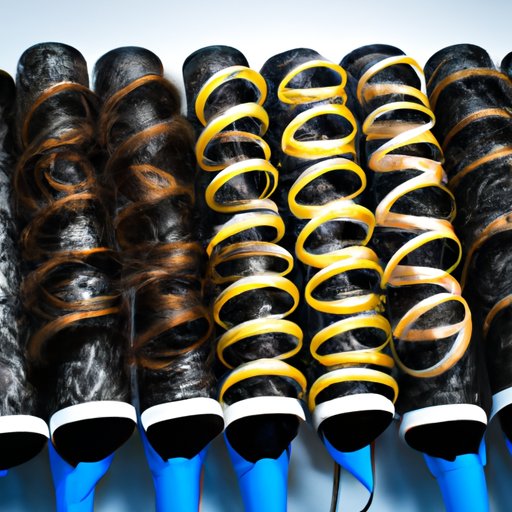Introduction
Curly hair is a beautiful and unique trait that many people strive to achieve. But what exactly causes it? What makes hair curly? In this article, we’ll explore the science, genetics, products, and styling methods of curly hair to better understand what makes it so special.
Explore the Science Behind Curly Hair
The shape of our hair is determined by the structure of our hair follicles. These follicles are shaped differently from person to person, which is why some people have straight hair, while others have naturally curly or wavy hair. The shape of the follicle affects how the hair grows out of the scalp, which ultimately determines its texture and curl pattern.
At a more scientific level, the shape of the hair follicle is determined by the way the cells divide and grow as the hair shaft develops. This process is affected by several biological and chemical processes, such as hormones, protein synthesis, and the production of keratin.
Different Types of Curls
There are many different types of curls, ranging from loose waves to tight coils. Each type has its own unique characteristics and requires different care routines. Here are some of the most common curl patterns and textures:
- Loose Waves – Loose waves are defined by soft S-shaped curls that create a gentle flow. This type of curl is often seen in people with fine, thin hair.
- Tight Curls – Tight curls are characterized by small, tightly coiled ringlets. This type of curl is often seen in people with thicker, denser hair.
- Coily – Coily hair is characterized by tight, kinky curls. This type of curl is often seen in people with naturally African American hair.
When caring for curly hair, it’s important to keep in mind that each type requires different treatments. For example, coily hair may require more moisture than other curl types, while loose waves may need more heat protection. It’s also important to use products specifically designed for curly hair to ensure the best results.
Genetics of Curly Hair
So why do some people have naturally curly hair, while others don’t? The answer lies in our genetics. Our genes determine the shape of our hair follicles, which in turn determines whether our hair is straight, wavy, or curly. This means that if both of your parents have curly hair, you’re likely to have curly hair too.
However, it’s important to note that even if both of your parents have curly hair, you may not necessarily have curly hair yourself. This is because there are other genetic factors at play, such as the shape of your skull and the way your scalp produces sebum (the natural oil produced by your scalp). All of these factors can affect the shape of your hair follicles and the texture and curl pattern of your hair.
Curly Hair Products
Using the right products is essential for keeping your curls looking their best. There are many different types of products designed specifically for curly hair, such as shampoos and conditioners, leave-in treatments, styling creams, oils, and gels. These products are designed to moisturize, protect, and enhance your curls, making them easier to manage and style.
It’s important to choose the right products for your curl type. For example, if you have coily hair, look for products that are specifically designed for coily hair. These products will be formulated with ingredients that will nourish and hydrate your curls, making them easier to manage and style.

How to Get Curly Hair
If you don’t have naturally curly hair, there are several ways to get the look. Heat styling is one of the most popular methods, and there are many tools available to help you achieve the perfect curls. Curling irons, wands, and flat irons are all great options for creating long-lasting curls.
Rollers are another option for getting curly hair. They come in various sizes and shapes, so you can choose the ones that work best for your hair type. Rollers can help create tight, bouncy curls, or looser, more relaxed waves, depending on the size and shape you choose.
If you’re looking for a more natural approach, there are several methods you can try. Braiding, twisting, and knotting are all great methods for creating long-lasting curls without the use of heat. You can also use scrunching techniques to create soft, beachy waves.
Different Curly Hair Styles
Once you’ve achieved the perfect curls, you can experiment with different styles. From classic updos to modern braided looks, there are endless possibilities when it comes to styling curly hair. When creating a style, it’s important to consider your curl pattern and texture. For example, if you have tight curls, a loose updo may not hold as well as a more structured style.
It’s also important to remember that curly hair can be fragile, so it’s best to avoid using too much heat or product. If you’re looking for more volume or definition, try using a diffuser or a light-hold hairspray instead.
Conclusion
Curly hair is a unique trait that many people strive to achieve. Understanding the science, genetics, and styling methods behind curly hair can help you better care for your own curls and create stunning styles. With the right products and techniques, you can embrace your curls and rock any look.


